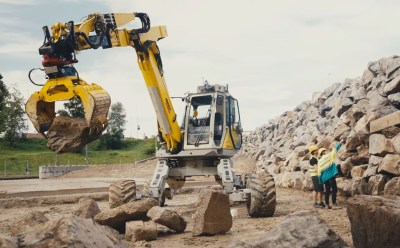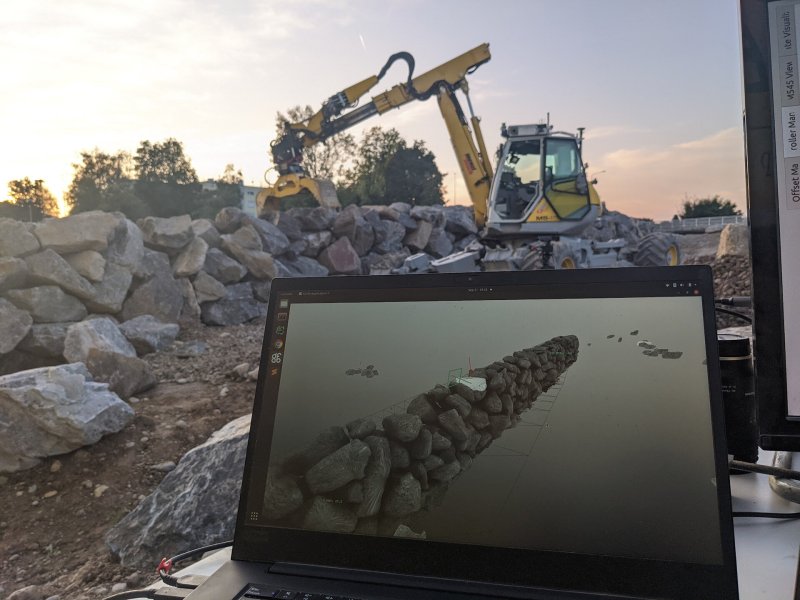In a move that aims to further the circular economy of the construction industry, researchers at ETH Zurich have let an autonomous excavator loose on a big pile of boulders and reclaimed concrete. The goal? To build a 20 foot (6 meter) and 213 ft (65 m) long dry-stone wall as part of a park where the landscape was digitally planned, and the earth autonomously excavated.
 The coolest thing about the Menzi Muck excavator is the software, which is explored in the video after the break. Thanks to a bunch of sensors, the excavator can not only draw a 3D map of the site, it can find in situ boulders dotting the landscape and incorporate them into the wall.
The coolest thing about the Menzi Muck excavator is the software, which is explored in the video after the break. Thanks to a bunch of sensors, the excavator can not only draw a 3D map of the site, it can find in situ boulders dotting the landscape and incorporate them into the wall.
Machine vision allows the excavator to grab the stones and assess their size and shape, as well as approximate their weight and center of gravity.
Then, an algorithm determines the best place for each stone and places them there without using mortar or cement. Menzi Muck is capable of number-crunching 20 to 30 stones at a time, which coincidentally is about the number in one delivery.
Want to build your own excavator? Check out this finely-detailed R/C excavator for top-notch inspiration.

















It not only scans the rock’s physical geometry but applies textures as well?
“A forward-facing RGB camera (Flir Blackfly) is mounted at the base of the cabin for capturing stone texture
information, and a roof-mounted camera is is employed for stone segmentation.”
Some years ago I predicted busy city centre construction would be done by shutting a team of autonomous machines behind the hoardings and beaming a CAD drawing in to them , come back in 2 weeks! This is surely the first step.
>The coolest thing about the Menzi Muck excavator is the software
NO not really,
Any teleoperated excavator can be loaded with sensors and software.
The coolest thing about the Menzi Muck is its incredible terrain negotiating capabilities. https://youtu.be/19yiVL-VWbU?si=k2igtG4DQ5HgfECa
Walking/Spider excavators are modern mechs. https://youtu.be/KeRTirDjo7U?si=zcOCVP-QeiozvgOb
Saying the software isn’t the coolest part because any excavator can have software is like saying any car isn’t cool because any wheel can have an engine bolted on, or any author isn’t great because any pencil can have a writer holding it.
If someone implements CommaAI self driving features on a Koenigsegg Gemera and HAD claims “The coolest thing about the Koenigsegg Gemera is the self driving software” I would have replied “No not really, Any car with drive by wire can take software and sensors. The coolest thing about the Koenigsegg Gemera is its implementation of camless FreeValve technology.”
https://www.youtube.com/watch?v=OZWeNPi2XkE
My statement wasnt that ANY excavator can have software
My statement was that WITH or WITHOUT being the testbed for this experimental project which could be implemented on ANY excavator WITH teleoperation capabilities THE COOLEST THING ABOUT THE MENZI MUCK is its incredible terrain negotiating capabilities. Which are not highlighted by this video in any way. I then ADD VALUE to the conversation by dropping eyecandy to support my statement as many people are unfamiliar with Walking/Spider excavators.
You started your comment “NO not really”. You’d have a leg to stand on if you’d said “that software sure is cool, another cool thing about the machine they used is…” but you didn’t, you were just dismissive of the project and started talking about something else.
A leg to stand on? Seriously? Who are you? Your not my employer, my parent, or my professor. Your critique of my words is worthless to this discussion at hand.
Your here playing editor and dictator as if you matter at all.
I have my opinion, you have yours
NO NOT REALLY, are the words I chose to dismiss a writers over enthusiasm as an intro to what I felt was the COOLEST thing about the Menzi Muck.
If you are so stimulated by pedantic pissantry go to reddit. Im sure youll find plenty of people keen to suffer your fetish. Im done bothering with you.
Moderators of HAD please cleanup this mess. Feel free to delete EVERY post Ive made in this thread if you feel that Shannons whining whinging critique of me sharing the videos of the MUCK’s Best features offends. But feel free to leave it if theres ANY worth or interest that valid.
Dry stone walls are really cool. The video doesn’t say how they’re arranging the stones, but the way traditional walls are made is that each stone touches the ones below it in exactly three places. Because they’re supported by a tripod, there is no way they can rock or move, allow the wall to be completely solid. They’re fragile at the top because those stones aren’t held down (which is why you should never climb over a dry stone wall) but everywhere else can be really strong.
I’ve actually been wondering whether you could machine-build dry stone walls for a while. Being able to reconstruct random rubble into something useful without having to spend energy on cutting, melting or reforming it would be incredibly cool. It’s great to see someone doing it, and on such a big scale.
Not how a stone mason builds one, AND the top is just as structural as the bottom. There’s this aqueduct in Spain that’s been dry set for the last couple thousand years. Lovely sight.
A stone mason doesnt build dry stone walls. That is the territory of dykers. Two very different skills and results. Shaping stone is quite labor intensive and quite often unnecessary for the purpose at hand.
And the STILL standing dry stone walls of Skara Brae in Orkney, Scotland were stacked several thousand years before the first aquaduct, Though the majority of that lovely site had to be excavated in modern times.
In my part of the world dry stone walls, or what we call hedges, are made with a core of soil and have plants growing in and on them. They become very strong when they’re left to do their thing. Some people in modern times have moved back here from the cities and thought that the hedges should be ‘restored’ to bare stones, after which the hedge will last a couple of years then collapse.
Well good news, how the stones are arranged is detailed in the paper they published. https://www.science.org/action/downloadSupplement?doi=10.1126%2Fscirobotics.abp9758&file=scirobotics.abp9758_sm.pdf
Nitpick: Menzi Muck is a brand name, not the name of this project. It’s the Kleenex of walking excavators, at least in Switzerland.
It says Menzi Muck right on the side of it. ETH Zurich didn’t build the excavator from scratch.
But yes, the article text should probably focus on THIS excavator having interesting software, not imply that it’s related to Menzi Muck.
It may come about my yard for a few bits. just to test it further.
Should be electric, too.
Several large construction companies are adding autonomous features to construction equipment already. Having it scan for in situ material seems rather novel but that is what research groups are for
Whoever did the turd in that picture needs to drink more water.
Are we going to talk about the puny humans standing in the working area of a ‘boulder identifying’ robot, while it holds a boulder aloft? Reminds me of the recent death by box handling robot in South Korea.
You just pulled that BS statement out of thin air, there is nothing to point to to justify your bizarre claims.